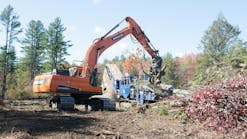For most general contractors, sidewalk preparation and grading can be a nuisance. With their large earthmoving machines, sidewalk grading is “finer work” than they can do efficiently, and the concrete contractor never seems happy with the resultant grade. In many cases, the concrete contractor has to dig out high spots and fill in low spots, and often finds himself pouring more concrete than is necessary, to compensate for the uneven grade.
PHOTO: TOPCON This problem is virtually solved by Eatonville, WA–based Sidewalk Grading Systems’ SGS 2000 (www.sgs-2000.com), a revolutionary attachment to compact excavators that provides a precise grade on which to set concrete forms. Using an SGS 2000, the job can be accomplished at a lower price than with traditional methods, and often in half the time.During 2004, in Thurston County, WA, general contractor Tucci and Sons developed “Jubilee,” a 134-lot residential area, which included a professional golf course. Sidewalk Grading Systems (SGS) was hired to prepare grade for 12,000 lineal feet of double-ribbon sidewalk and 130 driveways. SGS completed the project in 10 days at a lower per-unit cost than with traditional grading methods.“The soil bed was sandy gravel,” recalls Torrey Johnson, Jubilee’s project manager. “I believe our project was the first time SGS had done a vertical curb, instead of a rolled curb and gutter.“There was also a planter strip inside the curb and gutter. In 10 days we were finished—the grading, the forming, and the concrete pour—at a significantly lower cost than what we could have done ourselves. I think there was a 57-square-yard difference between their cost and ours. The SGS 2000 worked pretty good, although during the project [SGS] realized their current model needed to be a bigger machine, with a bigger arm. Their next prototype included that, and a GPS setup, for even more accuracy. Depending upon their availability, we might use them again, as our jobs often have tight, high-impact schedules.”Earlier this year, SGS served Tucci and Sons once again, for a 40,000-foot job of 5-foot sidewalks. The Washington State Department of Transportation project, on SR 167, one of the state’s most congested roadways, was a time-critical job; SGS worked at night when two of the road’s four lanes were closed to traffic.“SGS seemed to work fairly well,” Mike Cooper, Tucci’s head estimator, reports. “They made modifications on the job from what they originally started doing—during the project, they had to fix the slope of debris, make it according to specs. Right now I couldn’t evaluate how much money they saved us—but I know using SGS freed up a lot of our people, without costing money, to get sidewalks done. SGS did it, smooth and fast, for about the same money as we’d bid.”“We believed there had to be a better way to grade sidewalk areas,” says SGS’s General Manager Bill Culliton. “Traditional methods used very large machines, such as ’dozers, to try to make the grade ‘close.’ Due to the machines’ size, you couldn’t work parallel to the sidewalk; you had to work perpendicular to it, which doesn’t allow you to get a very fine grade. The solution has always been to grade low, and then the general contractor would put in sand or crushed gravel to make the sidewalk bed level—a task accomplished with rakes, shovels, and hand compacters—lots of additional labor.“We come through after you have the area two- or three-tenths within grade. Our machine rides on the curb as a reference point, and the grading blade is operated by the Topcon (www.topcon.com) leveling system. As we drive along the curb and level, the concrete crews can work behind us, putting in forms—we’re an extra step that saves money and time,” Culliton says.The SGS 2000, which has evolved through four prototypes, now only fits the Komatsu PC50, “but we’ve also attached it to a Cat, and we’re exploring the possibility of adapting it to John Deere and Bobcat models. Minor modifications must be made to the machines so we can attach our blade, and we need to get manufacturers to approve our attachment,” he explains. “The blade and its process is our invention; we adapt it to excavators, and are looking to do so, to sell the finished equipment outside the western Washington area.”The machine’s operation isn’t its only advantage; the blade can be attached/detached in less than 30 minutes, whether one is packing up to go home or changing the angle to work another area. “Mobility is a real plus for our method,” Culliton adds. “A 2-ton pickup with a trailer can move it—the excavator, blade, and roller.”Ceccanti Construction’s Bonney Lake project included 5,200 lineal feet of 5-foot-wide sidewalk, and when SGS arrived on the scene, no asphalt was yet on the roadway. The SGS 2000 made one pass in the native windrow provided by the contractor, and then two more passes in the five-eighths rock for the final grade—all within three days.“SGS gave me a 30% to 40% savings over what it would’ve cost me and my guys with a backhoe,” states Don Hanks, Ceccanti’s superintendent. “Plus, they did it in about half the time it would have taken me. Their grade was right on—the machine worked really good. I’d have a hard time not using them when I do another sidewalk.”In Tacoma, WA, Woodworth Construction had a “small job,” 2,600 feet of 5-foot sidewalk, on which the company tried the SGS process, because it was short on crews and needed to get the job done. “The project worked out very good; the SGS folks were very professional, and they turned out a good product, saving us about 30% in costs,” says Project Manager Mark Ballman. “With the machine they’ve developed for this application, they’re more efficient than any other way I’ve seen before. That’s a good machine they have there; they could corner the market with it.”A fifth prototype of the machine is now underway. “We’ve modified it for manufacturing purposes,” Culliton explains. “We’ve refined the process, made it more simple for a manufacturer to build the machines for us. We’re in the process of making four units to sell to others; we own and operate two. The SGS 2000 will carry a list price of about $89,000, which includes the excavator—but right now we’re making $300 an hour by using our machines on projects, so it won’t take buyers very long to see the machine pay for itself. There aren’t too many areas of the land development industry in which you’re rewarded for saving money—yet, even doing so, here we are, making profit for our customers, because we can help them finish the job in less time, for less money.” Culliton estimates that bid pricing for finish costs is in the neighborhood of $0.25 per square foot, $1.25 per lineal foot, and $2.25 per cubic yard.Another thing discovered during the prototyping phase: “Before a sidewalk gets signed off by authorities, the process has left a 4- to 6-inch drop in the lot. Contractors or the landscaper have to backfill against that, taper it to ground next to it. Our equipment can also be used to taper the grade, to backfill—a process that used to be done by hand. We can use the blade and bucket of the machine to do this. Fill up the blade, grade the dirt—almost like frosting a cake.”


